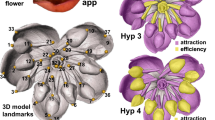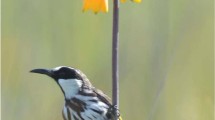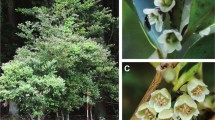Abstract
Some plants have evolved flowers of extraordinary depth, a phenomenon which puzzled Darwin1. Darwin suggested that the evolution of deep flowers could be a response to a kind of 'race' with pollinating insects: the length of the tongues of pollinating insects could increase as a result of a general size increase, or because it increased their nectar foraging efficiency. As this occurred, plants with relatively shallow flowers could be disadvantaged since pollen transfer, which is effected by physical contact between the pollinator and the anthers or stigma of the plant, could be reduced when the insect tongue is long relative to flower depth. This could lead to the evolution of increasing flower depth which in turn could drive the evolution of a further increase in insect tongue length. Various predictions of Darwin's proposal were tested here for orchid species with deep flowers that are pollinated by moths. It was found that insects do indeed insert their probosces no further than necessary to obtain nectar; that an experimental reduction in flower depth reduces both the male and female components of fitness; and that in natural populations there is a correlation between flower depth and female fitness measured by fruit set. These results all support Darwin's hypothesis to explain the evolution of flower depth.
This is a preview of subscription content, access via your institution
Access options
Subscribe to this journal
Receive 51 print issues and online access
$199.00 per year
only $3.90 per issue
Buy this article
- Purchase on Springer Link
- Instant access to full article PDF
Prices may be subject to local taxes which are calculated during checkout
Similar content being viewed by others
References
Darwin, C. On the Various Contrivances by which British and Foreign Orchids are Fertilised by Insects (Murray, London, 1862).
Darwin, C. On the Origin of Species (Murray, London, 1859).
Rothschild, L. W. & Jordan, K. Novit. zool. 9 (suppl.), 1–972 (1903).
Nilsson, L. A., Jonsson, L., Rason, L. & Randrianjohany, E. Biol. J. Linn. Soc. Lond. 26, 1–19 (1985).
Nilsson, L. A. Bot. Notiser 131, 35–51 (1978).
Miller, R. B. Evolution 35, 763–774 (1981).
Gregory, D. P. Aliso 5, 357–419 (1963–1964).
Nilsson, L. A. Bot. J. Linn. Soc. Lond. 87, 325–350 (1983).
Nilsson, L. A., Jonsson, L., Ralison, L. & Randrianjohany, E. Biotropica 19, 310–318 (1987).
Nilsson, L. A. & Rabakonandrianina, E. Bot. J. Linn. Soc. Lond. 97, 49–61 (1988).
Miller, R. B. S. West. Nat. 30, 69–76 (1985).
Inoue, K. J. Fac. Sci. Tokyo Univ. 13, 285–374 (1983).
Grant, V. & Grant, K. A. Bot. Gaz. 144, 280–284 (1983).
Grant, V. & Grant, K. A. Proc. natn Acad. Sci. U.S.A. 80, 1298–1299 (1983).
Grant, V. Bot. Gaz. 144, 439–449 (1983).
Darwin, C. On the Various Contrivances by which British and Foreign Orchids are Fertilised by Insects 2nd edn (Murray, London, 1877).
Inoue, K. Pl. Spec. Biol. 1, 207–215 (1986).
Løjtnant, B. Feddes Rep. 89, 13–18 (1978).
Vogel, S. Blütenbiologische Typen als Elemente der Sippengliederung (Fischer, Jena, 1954).
Author information
Authors and Affiliations
Rights and permissions
About this article
Cite this article
Nilsson, L. The evolution of flowers with deep corolla tubes. Nature 334, 147–149 (1988). https://doi.org/10.1038/334147a0
Received:
Accepted:
Issue Date:
DOI: https://doi.org/10.1038/334147a0
This article is cited by
-
Bees: potent pollinators of Leucas nutans (Lamiaceae)
Arthropod-Plant Interactions (2023)
-
Pollination inaccuracy: estimating male fitness in the movement-assisted dichogamous species Clerodendrum infortunatum
Evolutionary Ecology (2023)
-
Relaxed selection and the evolution of the chasmogamous flower of Impatiens capensis (Balsaminaceae)
Evolutionary Ecology (2022)
-
Is there spatial variation in phenotypic selection on floral traits in a generalist plant–pollinator system?
Evolutionary Ecology (2019)
-
Nectar composition in moth-pollinated Platanthera bifolia and P. chlorantha and its importance for reproductive success
Planta (2019)
Comments
By submitting a comment you agree to abide by our Terms and Community Guidelines. If you find something abusive or that does not comply with our terms or guidelines please flag it as inappropriate.



